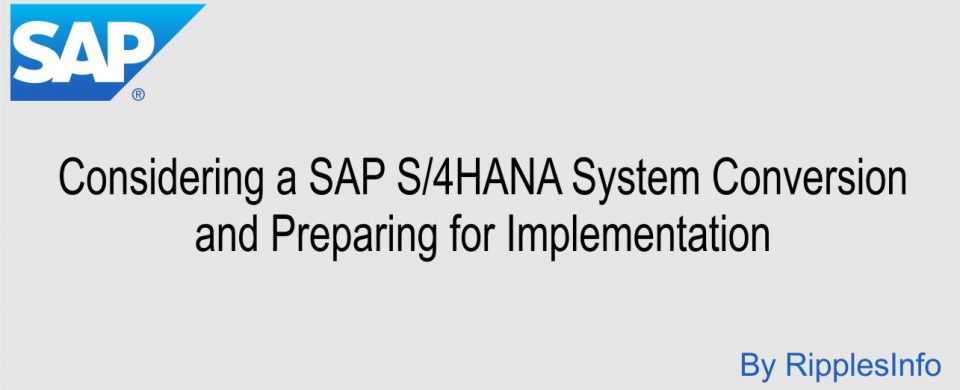Considering an SAP S/4HANA System Conversion and Preparing for Implementation
SAP S/4HANA was launched back in 2015 as a totally rebuilt version of the SAP Business Suite, running on the SAP HANA database.
With its renovated data model, SAP S/4HANA is its own product, rather than a follower to SAP ERP. This means corporations will need to do more than just upgrade their legacy system to use SAP S/4HANA.
SAP has published a 2027 deadline for companies to shift to SAP S/4HANA (with an alternative for extended SAP ERP preservation through 2030 for those who are however transitioning by the cutoff date). By then, firms on SAP ERP who plan to remain with SAP will require to make the switch to SAP S/4HANA. There are different ways to fulfill this, including brownfield, greenfield, and hybrid implementations. Deciding which strategy works best is based on the precise needs and goals of an establishment. In this blog post, we’ll explore the brownfield strategy, contribute acumen on what it suggests for your firm, and explain what to consider when preparing a migration.
Brownfield Implementation
A system conversion often related to as a “brownfield” approach, is an implementation plan that is achieved by exercising an present SAP ERP system and transforming or converting it to SAP S/4HANA. This signifies that an organization’s existing master and transactional data, custom development objects, and system customizations will be migrated to their new SAP S/4HANA system once the conversion is finished. This is denied to a new implementation (or greenfield implementation), which is an alternative path corporations prefer when they select to build their SAP S/4HANA system from scratch; or a composite or hybrid implementation, which fuses aspects of both greenfield and brownfield, and varies from firm to firm.
A conversion can be performed in one step in most maximum cases; nevertheless, if you have a practice older than SAP ERP 6.0, you’ll be expected to complete a two-phase method. In the two-phase situation, the primary step is to upgrade your system to a sustained source release. Then, you will be able to transform it to SAP S/4HANA.
It’s essential to note that not every system can be converted to SAP S/4HANA as-is, because several prerequisites must be met. For example, add-ons and all business roles need to be congenial with the new system. If they are not compatible, you need to remove any incompatibilities or variances before transforming or choose the greenfield approach.>/p>
Brownfield Conversion Pros
A brownfield approach is usually less expensive since you’re exercising surviving data and assigning it to another section, eliminating the necessity to reconstruct your landscape. By combining legacy data into your SAP S/4HANA system, you need not have to exercise the time to redesign specific processes. Your master data automatically migrate’s over to the fresh system, assisting you of having to extract and load it as you would if you continued beginning a brand-new project (the greenfield choice). An added advantage of a brownfield approach is that the conversion is a chance to clean and eliminate old custom code or lessen the data footprint via data archiving.
Brownfield Conversion Cons
One issue several organizations cannot risk ignoring when it proceeds to a brownfield project is the time it takes to accomplish the migration. As discussed above, firms can benefit from the data cleanup a conversion presents, but it reaches a timely cost. Furthermore, the conversion has to be prepared all at once, which implies all effort and work will be put to a standstill. How much time the conversion will demand will diversify based on the individual organization’s landscape—the larger and more complex a landscape, the more time the conversion will be demanded. A migration also needs a bit of rework and restructuring to your new system.
SAP S/4HANA System Conversion Guide
It can be very amazing to execute a system conversion, particularly if you’ve never made one before. SAP S/4HANA System Conversion Guide supports companies and consultants to prepare and execute their migrations.
You’ll begin with an introduction to SAP S/4HANA, examine the concept of simplification, and study about the supported conversion methodology. Then, jump into SAP S/4HANA architecture, conversion tools, strategy, and project planning.
The conversion method is looked at more approximately when you move considerably into the book. Several elements and tools that are needed to complete the conversion are explained, along with an analysis of how to reach them.
Study the technical side of the conversion from SAP ERP to SAP S/4HANA by running through a whole conversion using the Software Update Manager (SUM) with the Database Migration Option (DMO). Review the post-processing exercises that accompany the conversion.
Know how to complete the change adjustment for Data Dictionary objects with Transaction SPDD and go by several adjustment transactions. Then, take a glance at the influence custom code has on your system and the essential exercises to deliver a custom code migration.
Wind up with a conversation regarding the essential conversion of customers and suppliers to industry partners, and the actions that are required for a functional conversion of the financials and accounting, credit management, trade finance, logistics, and sales and distribution lines of business.

